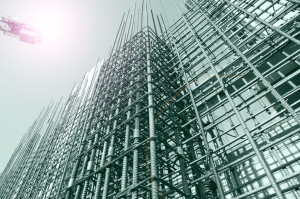What are beams and columns in structural engineering?
 From the ancient Pyramids of Giza to modern-day Borj Khalifa, we have accomplished several civil engineering feats in our relatively short history. But when you think about it, this progress hinges on our ability to understand structural mechanisms.
From the ancient Pyramids of Giza to modern-day Borj Khalifa, we have accomplished several civil engineering feats in our relatively short history. But when you think about it, this progress hinges on our ability to understand structural mechanisms.
You see, everything civil engineering you can think of – from huts to skyscrapers and bridges – all require structural elements to keep them standing.
Beams and columns are two such important structural elements, and they’ve been used for thousands of years. They play an important role in creating a safe load path to transfer the weight and forces acting on a structure to the foundation and into the ground.
In this article, we delve deeper into what they’re all about.
Beams
Beams are horizontal structural elements that withstand vertical loads, shear forces, and bending moments. Beams transfer loads imposed along their horizontal length to endpoints, such as columns, walls, and foundations.
To give you a concrete example, let’s examine a bridge. During the construction of a bridge, giant structural elements are erected into the floor. These structural elements are referred to as columns – but more on that later.
Then, long horizontal elements (typically made of reinforced concrete or steel) are placed between the ends of the columns. These horizontal elements are referred to as beams. In the case of a bridge, they carry the weight of the vehicles moving on the bridge and transfer it to the columns.
Another good example of a beam would be the balancing beam in gymnastics. A 15-feet long beam is supported at both ends. Now, when the gymnastics perform her stunts on the beam, she is acting downwards perpendicular to the longitudinal direction of the beam.
In buildings, beams are used to support the weight of ceilings, roofs, and floors.
Design of Beams
The design of beams involves the selection of the proper beam size, area, and material that will carry the applied load without failing or deflecting excessively. Coming to the right conclusion requires an adept understanding of physics and engineering statics.
Structural engineers are trained to analyze loads, forces, and stresses acting on beams. And they use their insight to determine the best material, size, and shape.
Material
The most common types of materials used for beams include:
1) Reinforced concrete
2) Steel
3) Grouted masonry
4) Wood
All materials have their pros and cons. For instance, steel beams are recyclable, durable, and rust-resistant. But on the downside, they have high maintenance costs, are less resistant to fire, and are difficult to maneuver.
But at the end of the day, the final selection of material is usually based on cost, size, and functional purpose.
Size and Shape
The dimension of a beam is directly proportional to its load-bearing properties. The thicker the beam, the bigger the load it can carry without failing.
Column
By now, you should have a good idea of what a column is. But here’s the formal definition. A column is a vertical structural member intended to transfer compressive load.
To give a basic example, consider a four-legged table. The four legs of the table can be seen as columns. And the weights of the wooden slab and objects on the table are transferred to the legs, which in turn transfers them to the floor as compression.
If you transfer this idea to a tall building, the columns at the bottom floor help carry the cumulative weight of all the floors above it.
Location
To attain the best load distribution, columns should be spaced consistently throughout all floors. That’s precisely why the columns in bridges are usually spaced equally.
But sometimes, the proposed architectural design on a structure might put practical limitations in following this rule. When that’s the case, the structural engineer has to work closely with the architect to determine the ideal column layout given the design constraints.
Materials
In modern construction, columns are primarily made from two types of materials:
1) Steel
Steel columns can be classified into three types. They are C-section, I-section, and hollow section.
2) Reinforced concrete
Reinforced concrete is typically design as rectangular or circular sections.
In classical architecture, stones were popularly used as columns.
Design
When designing the columns of a new building, the structural engineer considers several things. First, they calculate the weight of the floors/roof and other loads extruding vertical forces supported by these columns.
What’s more, the effects of lateral forces due to earthquakes and wind must also be taken into account. Based on the resulting values, the structural engineer determines the ideal material, size, and shape.
Wrap Up
Without beams and columns, structures would be unable to stand uprightly. And although there’s a lot more to structural elements, you should now have at least a rudimentary idea of what they’re all about.
Contact us here today for more information. We look forward to working with you on your next project!

